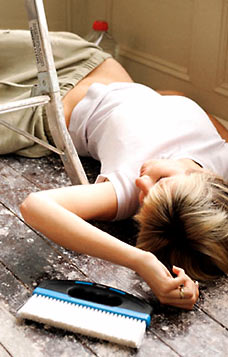Fainting refers to a brief loss of consciousness caused by an inadequate blood pressure, significantly reducing the blood supply to the brain. Your blood vessels respond to situations by changing their diameters, for example, when you stand up, your blood vessels constrict in order to manage the effects of gravity.
Many fainting cases do not lead to adverse effects and are often short-lived. Usually stress, pain or extreme heat causes the blood vessels to dilate to decrease blood pressure. A casualty may recover within a few seconds, but the effects of the illness may continue for a few more minutes. If the effects are persistent and the unconsciousness is prolonged or recurrent, call emergency medical help immediately as the collapse may be a symptom of other complications such as shock or stroke.

Causes of low blood pressure
- Standing for too long
- Extended bed rest
- Dehydration
- Neuropathy
- Medication that causes changes in blood pressure
- Irregular heart beats
- Emotional distress or fear
- Severe pain
- Extreme heat
- The sight of blood
- The sight of a sharp hypodermic needle
- Other events that may emotionally stress, shock or arise fear in the person
Symptoms
- Light headache
- Dizziness
- Pale skin
- Nausea
- Perspiration
- Restlessness
- Anxiety
- Collapse
- Unconsciousness
Severe symptoms
If any of these symptoms occur, contact emergency medical help immediately:
- Heart palpitations
- Breathlessness
- Chest pain
- Irregular pulse
- Slurred speech
- Changes in facial expressions such as drooping eyes and mouth
- Weakness in the limbs
Treatment
If you are feeling faint, lie down or sit down to prevent yourself from fainting again. Put your head between your knees and remain in this position for a few minutes.
If another person faints, follow these steps:
- Lay the person down properly and raise his legs above heart level to encourage blood circulation.
- Loosen any tight clothing and unbuckle belts. Do not allow the person to get up quickly to prevent him from fainting again. If the person does not restore consciousness, call emergency medical help immediately.
- Check the casualty’s airways for any obstructions.
- If the person is not breathing, begin CPR immediately and continue, until help arrives.
- If the person experiences any injuries due to the trauma of the collapse, stop any bleeding by applying pressure on the wounds with a sterile piece of cloth.
Learn More
To learn more about circulatory and breathing emergencies such as stroke or fainting take St Mark James training courses with a provider near you. Simply visit our location’s page to view the premier and credible providers nears you. Training locations can be found in Halifax, Toronto, Edmonton, Calgary, Vancouver and Winnipeg.
